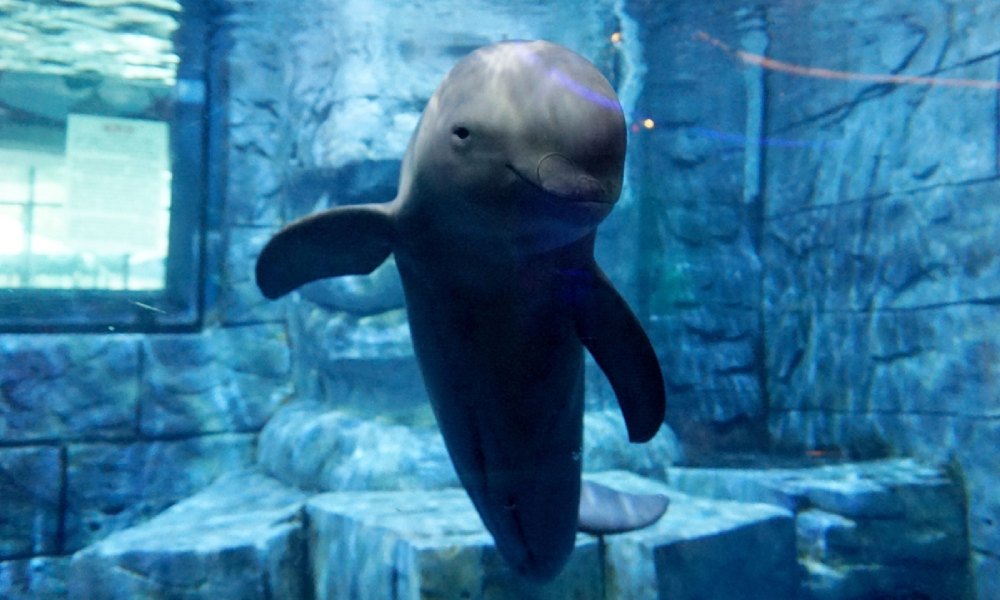The Yangtze Finless Porpoise (Neophocaena asiaeorientalis asiaeorientalis) is an extraordinary species that navigates the waters of the Yangtze River in China. As one of the few freshwater porpoises in the world, this aquatic mammal not only represents an evolutionary marvel but also serves as a critical indicator of the health of its ecosystem. Unfortunately, like many other riverine species, it is facing severe threats that jeopardize its survival.
Taxonomy and Physical Description
Belonging to the family Phocoenidae, the Yangtze Finless Porpoise is distinguishable by several unique characteristics. Unlike other porpoises, it lacks a dorsal fin—a feature that gives it its common name. Instead, it has a slight ridge along its back, which is dotted with small tubercles. This physical trait reduces drag, allowing it to navigate the murky waters of the Yangtze with remarkable agility.
Adults typically reach a length of about 1.2 to 2 meters and weigh between 30 to 45 kilograms. Their bodies are streamlined, with a rounded head and a small, indistinct beak. They exhibit a smooth, gray skin which can appear lighter on the underbelly. Their small, rounded flippers aid in precise maneuvering through the river’s complex environments.

Habitat and Distribution
The Yangtze River, the longest river in Asia and the third longest in the world, is the primary habitat of the Yangtze Finless Porpoise. Historically, these porpoises were found throughout the middle and lower reaches of the Yangtze, including its lakes and tributaries. However, their range has significantly decreased due to habitat fragmentation and degradation.
This freshwater porpoise prefers the quieter, shallower sections of the river and adjacent lakes. These areas provide abundant food sources and are less turbulent in comparison with the main river channel. Seasonal changes in water levels influence their distribution, with porpoises often moving to deeper channels during the dry season.
Behavior and Diet
Yangtze Finless Porpoises are known for their playful and inquisitive nature. They often swim in small groups of two to six individuals, though larger aggregations can occasionally be observed. Communication among these social animals is facilitated by a range of clicks and whistles, which they use for echolocation and social interaction.
Their diet mainly consists of a variety of fish species, as well as shrimp and other small invertebrates. The porpoises use echolocation to hunt, emitting sound waves that bounce back from prey, enabling them to detect and capture food even in the turbid waters of the Yangtze.
Conservation Status and Threats
The Yangtze Finless Porpoise is classified as Critically Endangered on the International Union for Conservation of Nature (IUCN) Red List. Its population has plummeted over the past few decades, with current estimates suggesting that fewer than 1,000 individuals remain in the wild. Several factors have contributed to this dramatic decline:
1. Habitat Loss and Degradation: Extensive development along the Yangtze River, including dam construction, sand mining, and land reclamation, has led to significant habitat loss and fragmentation. The Three Gorges Dam, one of the largest dam projects in the world, has had profound impacts on the river’s ecology.
2. Pollution: Industrial discharge, agricultural runoff, and domestic sewage have heavily polluted the Yangtze, deteriorating water quality and affecting the health of aquatic life. Chemical pollutants and heavy metals can accumulate in the tissues of porpoises, leading to various health issues.
3. Overfishing: Overexploitation of fish stocks in the Yangtze River has reduced the availability of prey for the finless porpoise. Additionally, bycatch—accidental capture in fishing nets—poses a significant threat, often resulting in injury or death for the porpoises.
4. Vessel Traffic: The Yangtze River is a major transportation route, with heavy boat traffic that leads to noise pollution and physical disturbances. Collisions with vessels are also a notable risk for the slow-moving porpoises.
Conservation Efforts
Recognizing the dire situation, various conservation measures have been implemented to protect the Yangtze Finless Porpoise. These efforts involve a combination of scientific research, habitat protection, and public awareness campaigns:
1. Protected Areas: Several nature reserves and protected areas have been established along the Yangtze River to safeguard critical habitats. Notable examples include the Tian-e-Zhou Oxbow Nature Reserve and the Yangtze Finless Porpoise National Nature Reserve.
2. Captive Breeding Programs: Captive breeding initiatives aim to create a viable population that can eventually be reintroduced into the wild. The Tian-e-Zhou Oxbow and the HeGongsha Breeding Center are key facilities in these efforts.
3. Pollution Control: Measures to reduce pollution in the Yangtze River basin are crucial for improving the health of the ecosystem. This involves stricter regulations on industrial discharge, better waste management practices, and promoting sustainable agricultural methods.
4. Public Education and Advocacy: Raising awareness about the plight of the Yangtze Finless Porpoise is vital for garnering public support and fostering a culture of conservation. Educational programs, media campaigns, and community engagement initiatives are crucial components of this strategy.
Conclusion
The Yangtze Finless Porpoise stands as a symbol of the unique biodiversity of the Yangtze River and the urgent need for conservation action. While the challenges are immense, the concerted efforts of governments, conservation organizations, and local communities provide a beacon of hope. By continuing to implement and expand these efforts, there is a possibility of reversing the decline of this remarkable species and ensuring that future generations can witness the playful grace of the Yangtze Finless Porpoise in its natural habitat.









